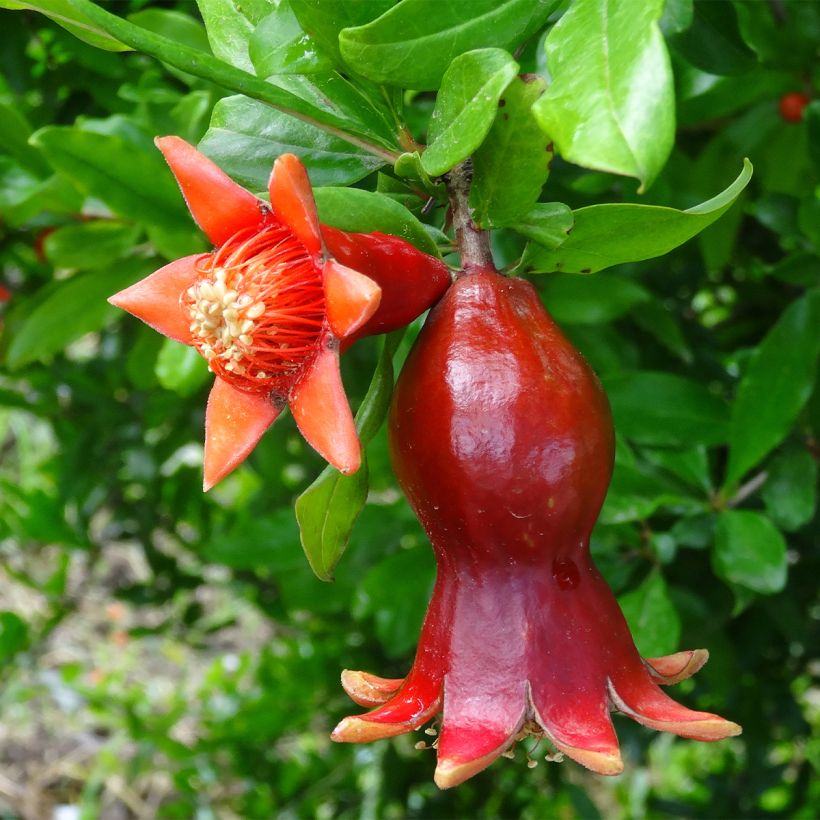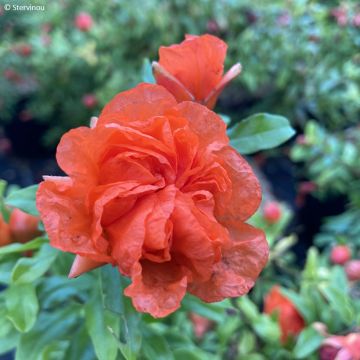

Punica granatum - Pomegranate


Punica granatum - Pomegranate


Punica granatum - Pomegranate


Punica granatum - Pomegranate


Punica granatum - Pomegranate


Punica granatum - Pomegranate


Punica granatum - Pomegranate
Punica granatum - Pomegranate
Punica granatum
Pomegranate
Very beautiful bush a little dry upon arrival, but a little watering has made it regain its good looks.
Pascal, 24/09/2023
Special offer!
Receive a €20 voucher for any order over €90 (excluding delivery costs, credit notes, and plastic-free options)!
1- Add your favorite plants to your cart.
2- Once you have reached €90, confirm your order (you can even choose the delivery date!).
3- As soon as your order is shipped, you will receive an email containing your voucher code, valid for 3 months (90 days).
Your voucher is unique and can only be used once, for any order with a minimum value of €20, excluding delivery costs.
Can be combined with other current offers, non-divisible and non-refundable.
Why not try an alternative variety in stock?
View all →This plant carries a 6 months recovery warranty
More information
We guarantee the quality of our plants for a full growing cycle, and will replace at our expense any plant that fails to recover under normal climatic and planting conditions.

Description
The Pomegranate Bush (Punica granatum) is a typical bush of the Mediterranean region, producing large juicy fruits in autumn, to be enjoyed in sweet or savory dishes. It offers highly decorative, bright orange-red flowers throughout the summer. It requires a lot of heat to bear fruit. Planting can be done throughout the year (except during frost), but preferably in autumn, for a harvest from September to December starting from the 4th or 5th year.
Pomegranates are round fruits, about the size of an apple, with a hard skin that turns orange-red when ripe. The interior is made up of thick white membranes, containing multiple seeds surrounded by a very juicy red pulp. It is these fleshy grains, called arils, that are consumed. Of course, pomegranate is used to make the famous grenadine syrup, but it is also consumed as juice, sorbet, in pastries, fruit salads, mixed salads, or as an accompaniment to poultry, for example. Rich in antioxidants and vitamins, pomegranate is a refreshing fruit with a slightly sour and sweet taste. It is harvested in autumn, about 4 to 5 months after flowering. Pick the fruits when the skin turns red and just begins to crack. Pomegranate does not ripen after harvest but can be stored for several months in a cool place. The first fruits appear on the bush from the 4th or 5th year.
Originally from India, the Pomegranate Bush (Punica granatum) belongs to the family of Punicaceae (Lythraceae). It is a self-fertile variety. From May to September, it offers large, highly ornamental, single trumpet-shaped flowers, of a bright orange-red. They will be followed in autumn by large juicy fruits, turning orange-red when ripe.
Cultivated since antiquity, it is a bush with a long lifespan, able to live up to 200 years, with slow growth. It has a spreading bushy habit with opposite lanceolate leaves. Slightly red and then shiny green in summer, they take on a beautiful coppery yellow colour in autumn before falling. The Pomegranate Bush will reach a height of about 5 m (16 ft 5 in). It can be planted in a flower bed, as a standalone plant, in an informal hedge, or in a pot. Hardy down to -15°C (5 °F), it requires a lot of heat.
Report an error about the product description
Punica granatum - Pomegranate in pictures






Plant habit
Fruit
Flowering
Foliage
Botanical data
Punica
granatum
Punicaceae
Pomegranate
Cultivar or hybrid
Planting and care
The Pomegranate tree thrives in all types of soil, including poor or limestone soils. Choose a very sunny exposure and a sheltered location. Outside the Mediterranean area, grow in a container. The Pomegranate tree needs a lot of heat to bear fruit and a little cold in winter to flower.
Planting can be done all year round (except during frost), but preferably in autumn. Hardy down to -15°C (5 °F), the Pomegranate tree appreciates well-drained and moist soils.
When planting, allow a space of 4 to 5 metres (13 feet 1 inches to 16 feet 5 inches) in all directions to allow for good development of the Pomegranate tree. Dig a hole, mix the soil with well-rotted compost or potting soil, place the root ball and cover with soil. Firmly press down and water generously. Install a mulch at the base to retain moisture in summer. Water in summer, when in flower. In spring, add compost if necessary.
For container cultivation, don't forget to put a layer of gravel or clay balls at the bottom of the pot to facilitate drainage. At the end of autumn, bring the pot indoors to a cold greenhouse. Repot every 3 years or so.
The Pomegranate tree is not very susceptible to diseases and pests.
Planting period
Intended location
Care
-
, onOrder confirmed
Reply from on Promesse de fleurs
Haven't found what you were looking for?
Hardiness is the lowest winter temperature a plant can endure without suffering serious damage or even dying. However, hardiness is affected by location (a sheltered area, such as a patio), protection (winter cover) and soil type (hardiness is improved by well-drained soil).

Photo Sharing Terms & Conditions
In order to encourage gardeners to interact and share their experiences, Promesse de fleurs offers various media enabling content to be uploaded onto its Site - in particular via the ‘Photo sharing’ module.
The User agrees to refrain from:
- Posting any content that is illegal, prejudicial, insulting, racist, inciteful to hatred, revisionist, contrary to public decency, that infringes on privacy or on the privacy rights of third parties, in particular the publicity rights of persons and goods, intellectual property rights, or the right to privacy.
- Submitting content on behalf of a third party;
- Impersonate the identity of a third party and/or publish any personal information about a third party;
In general, the User undertakes to refrain from any unethical behaviour.
All Content (in particular text, comments, files, images, photos, videos, creative works, etc.), which may be subject to property or intellectual property rights, image or other private rights, shall remain the property of the User, subject to the limited rights granted by the terms of the licence granted by Promesse de fleurs as stated below. Users are at liberty to publish or not to publish such Content on the Site, notably via the ‘Photo Sharing’ facility, and accept that this Content shall be made public and freely accessible, notably on the Internet.
Users further acknowledge, undertake to have ,and guarantee that they hold all necessary rights and permissions to publish such material on the Site, in particular with regard to the legislation in force pertaining to any privacy, property, intellectual property, image, or contractual rights, or rights of any other nature. By publishing such Content on the Site, Users acknowledge accepting full liability as publishers of the Content within the meaning of the law, and grant Promesse de fleurs, free of charge, an inclusive, worldwide licence for the said Content for the entire duration of its publication, including all reproduction, representation, up/downloading, displaying, performing, transmission, and storage rights.
Users also grant permission for their name to be linked to the Content and accept that this link may not always be made available.
By engaging in posting material, Users consent to their Content becoming automatically accessible on the Internet, in particular on other sites and/or blogs and/or web pages of the Promesse de fleurs site, including in particular social pages and the Promesse de fleurs catalogue.
Users may secure the removal of entrusted content free of charge by issuing a simple request via our contact form.
The flowering period indicated on our website applies to countries and regions located in USDA zone 8 (France, the United Kingdom, Ireland, the Netherlands, etc.)
It will vary according to where you live:
- In zones 9 to 10 (Italy, Spain, Greece, etc.), flowering will occur about 2 to 4 weeks earlier.
- In zones 6 to 7 (Germany, Poland, Slovenia, and lower mountainous regions), flowering will be delayed by 2 to 3 weeks.
- In zone 5 (Central Europe, Scandinavia), blooming will be delayed by 3 to 5 weeks.
In temperate climates, pruning of spring-flowering shrubs (forsythia, spireas, etc.) should be done just after flowering.
Pruning of summer-flowering shrubs (Indian Lilac, Perovskia, etc.) can be done in winter or spring.
In cold regions as well as with frost-sensitive plants, avoid pruning too early when severe frosts may still occur.
The planting period indicated on our website applies to countries and regions located in USDA zone 8 (France, United Kingdom, Ireland, Netherlands).
It will vary according to where you live:
- In Mediterranean zones (Marseille, Madrid, Milan, etc.), autumn and winter are the best planting periods.
- In continental zones (Strasbourg, Munich, Vienna, etc.), delay planting by 2 to 3 weeks in spring and bring it forward by 2 to 4 weeks in autumn.
- In mountainous regions (the Alps, Pyrenees, Carpathians, etc.), it is best to plant in late spring (May-June) or late summer (August-September).
The harvesting period indicated on our website applies to countries and regions in USDA zone 8 (France, England, Ireland, the Netherlands).
In colder areas (Scandinavia, Poland, Austria...) fruit and vegetable harvests are likely to be delayed by 3-4 weeks.
In warmer areas (Italy, Spain, Greece, etc.), harvesting will probably take place earlier, depending on weather conditions.
The sowing periods indicated on our website apply to countries and regions within USDA Zone 8 (France, UK, Ireland, Netherlands).
In colder areas (Scandinavia, Poland, Austria...), delay any outdoor sowing by 3-4 weeks, or sow under glass.
In warmer climes (Italy, Spain, Greece, etc.), bring outdoor sowing forward by a few weeks.










































